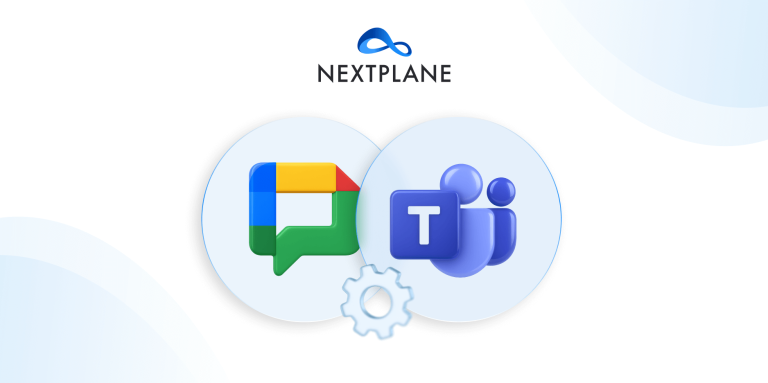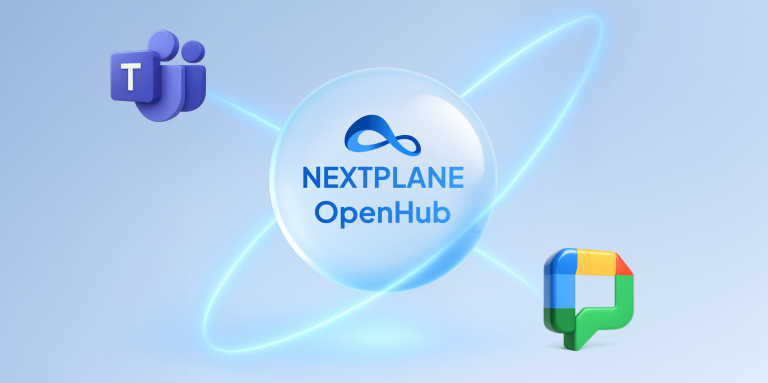Microsoft Teams vs. Zoom: Which Is Best for Your Business?

Table of contents
- 1. Overview of Microsoft Teams and Zoom
- 2. Market Share
- 3. Key Features Comparison
- 3.1. Communication and Collaboration
- 3.2. Video Quality
- 3.3. MS Teams vs Zoom Bandwidth Usage
- 3.4. Meetings, Conferencing & Webinars
- 3.5. Data Usage
- 3.6. Ease of Use
- 3.7. Integration and Extensibility
- 3.8. Microsoft Teams vs Zoom Rooms
- 3.9. Screen Sharing
- 3.10. Security and Compliance
- 3.11. Pricing and Plans
- 4. Industry-Specific Considerations
- 5. Microsoft Teams vs Zoom Comparison Chart
- 6. Which is Best for Your Business?
- 7. Extending Collaboration with NextPlane OpenHub
- 8. Conclusion
In today’s digital era, where remote work has become the norm for many businesses, choosing the right collaboration tool is more crucial than ever. Microsoft Teams and Zoom, renowned for their user-friendly interfaces, are two of the leading platforms in this domain. They offer a wide array of features to facilitate communication, collaboration, and productivity among teams. This comprehensive analysis aims to delve into the features, benefits, and potential drawbacks of Microsoft Teams and Zoom, helping you decide which platform best suits your business needs.
Overview of Microsoft Teams and Zoom
Microsoft Teams, a comprehensive collaboration tool, offers seamless integration with Microsoft 365 applications. This compatibility ensures that your existing systems can be easily incorporated, providing a unified workspace for workplace communication, collaboration, and file sharing. Teams’ features include chat, video meetings, voice calls, and extensive integration with Microsoft Office applications like Word, Excel, PowerPoint, and OneNote.
Zoom, primarily known for its video conferencing capabilities, has become a household name for virtual meetings. It offers high-quality video and audio conferencing, webinars, live chats, screen sharing, and other collaborative features. Zoom’s user-friendly interface, reliability, and scalability have made it a trusted choice for businesses of all sizes.
Market Share
Microsoft Teams has demonstrated its adaptability and market resilience, with a significant milestone of reaching 300 million monthly active users as of January 2022. Its popularity soared during the pandemic, as numerous companies already utilizing Microsoft 365 seamlessly transitioned to Teams for remote work, a testament to its enduring market presence and adaptability.
Zoom also saw explosive growth during the pandemic, reaching a peak of 300 million daily meeting participants in April 2020. As of December 2021, it had 509,800 customers with more than ten employees. Zoom remains the market leader in standalone video conferencing.
Key Features Comparison
Communication and Collaboration
Microsoft Teams integrates chat, file sharing, and video meetings directly within the platform. It also has deep integration with Microsoft 365 for real-time document collaboration. Teams channels can be customized with tabs, connectors, and bots to suit project or team needs, facilitating a highly organized and tailored collaboration environment.
Zoom focuses on delivering high-quality video conferencing and offers features like breakout rooms, virtual backgrounds, and touch-up appearance. Zoom recently changed the name of its main package to Zoom One to rebrand as a more comprehensive all-in-one collaboration tool. This means Zoom now has some great collaboration features (more robust chat, whiteboard, and live collaborative notes, to name a few). But these features are still nowhere near as advanced as Teams. This is because Teams was built as an all-in-one collaboration tool from day one, whereas Zoom began as a video conferencing tool—and is still in the early days of becoming something more. For starters, Teams offers a lot more chat functionality than Zoom. The screenshots below clearly show that Zoom chat, while passable, is a bit more essential compared to Teams.


Zoom chat has emojis. But what if you want to send stickers to your professional coworkers? In Teams, you can personalize stickers to call people out or reference projects you’re discussing.
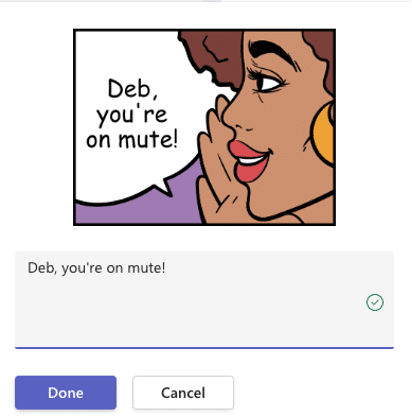
Video Quality
Both Teams and Zoom provide high-definition (HD) video. Zoom supports up to 1080p HD video, while Teams supports 720p HD video in 2×2 gallery view and 1080p in other views when using a full HD capable webcam.
Zoom is often cited as having slightly better video quality and performance overall. However, Teams has rapidly improved and offers comparable quality in most scenarios.
MS Teams vs Zoom Bandwidth Usage
Zoom recommends a minimum up-and-down speed of 1.2 Mbps for high-quality video calls and 1.8 Mbps for 1080p HD.
Teams adjusts video quality based on available bandwidth. It requires approximately 1.2 Mbps for HD group video calling and 1.5 Mbps for HD 1-on-1 video calling. Teams can still function on connections as low as 30 kbps.
Zoom may provide a more consistent experience in low-bandwidth environments, but both handle varying conditions well.
Meetings, Conferencing & Webinars
Zoom set the standard early on, focusing on simplicity, reliability, and features like virtual backgrounds. It handles large meetings of up to 1,000 participants and webinars with up to 50,000.
Teams has steadily closed the gap, matching many of Zoom’s features while leveraging its advantages in unified communication. Teams meetings max out at 1,000 participants, but its 20,000-person view-only broadcasts suit most webinar needs.
Zoom remains the go-to choice for organizations seeking a standalone solution for video meetings and webinars. However, Teams’ deep integration with Microsoft 365 provides a compelling option for those already in the Microsoft ecosystem.
Data Usage
Zoom uses roughly 540MB-1.62GB of data per hour for 1:1 calls and 810MB-2.4GB per hour for group calls.
Teams use 30MB-130MB per hour for 1:1 calls and 225MB-450MB per hour for group calls.
When comparing data usage between MS Teams and Zoom, MS Teams demonstrates greater efficiency, using substantially less data for both 1:1 and group calls. Teams is preferable for those with restrictive data limits or slower internet connections.
Ease of Use
Teams boasts a comprehensive set of features, which, while powerful, can sometimes result in a steeper learning curve for new users. Its deep integration with Microsoft 365 makes it a seamless addition for businesses already using Microsoft products.
Zoom is celebrated for its simplicity and ease of use. Setting up meetings and inviting participants is straightforward, making it accessible for users with varying levels of technical expertise.
Integration and Extensibility
Microsoft Teams offers extensive integration within the Microsoft ecosystem and hundreds of third-party applications, making it a versatile tool that can adapt to various workflows and business needs.
Zoom provides integration options with many applications, including Microsoft Teams, enhancing its functionality. However, its ecosystem is not as extensive as Teams, focusing on enhancing its core video and audio communication offerings.
Microsoft Teams vs Zoom Rooms
Microsoft Teams Rooms and Zoom Rooms cater to different business needs by enhancing collaboration in hybrid meeting scenarios. Microsoft Teams Rooms, integrated deeply with Microsoft 365, is tailored for internal team collaborations, featuring advanced security, AI-driven enhancements, and extensive Microsoft ecosystem integrations. Zoom Rooms, ideal for customer-facing settings, offers unique features like Kiosk Mode and digital signage to enhance visitor interactions. The choice between the two depends on your specific business requirements and existing technological infrastructure.
Two of the many benefits of Microsoft Teams Rooms are wireless content sharing and Teams panels. Teams panels are wall-mounted devices that provide meeting details and reserve meeting spaces.
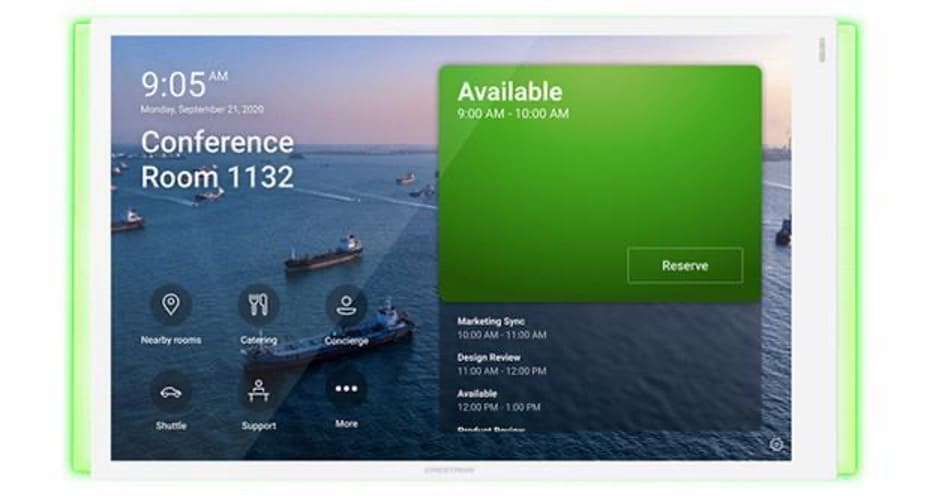
Another feature includes improved video meeting options with AI-powered voice and face recognition. With intelligent speakers, AI can identify who is speaking and add the person’s name to the meeting transcript.
Microsoft Teams Rooms also offers a collaborative workspace that anyone in the meeting can access. In Microsoft Teams, you can share your screen to a OneNote page, but only you can add to it.
Microsoft Teams standalone doesn’t have these features in its video meetings. It only has spotlighting, sharing screen options, and basic chat features.
Microsoft Teams is an app included in Microsoft 365. Microsoft Teams Rooms is a separate platform that integrates into Microsoft Teams to work alongside it.
So, Microsoft Teams Rooms has all the features of Microsoft Teams, with added benefits. The program aims to create seamless video conferencing between combined remote and in-person meetings.
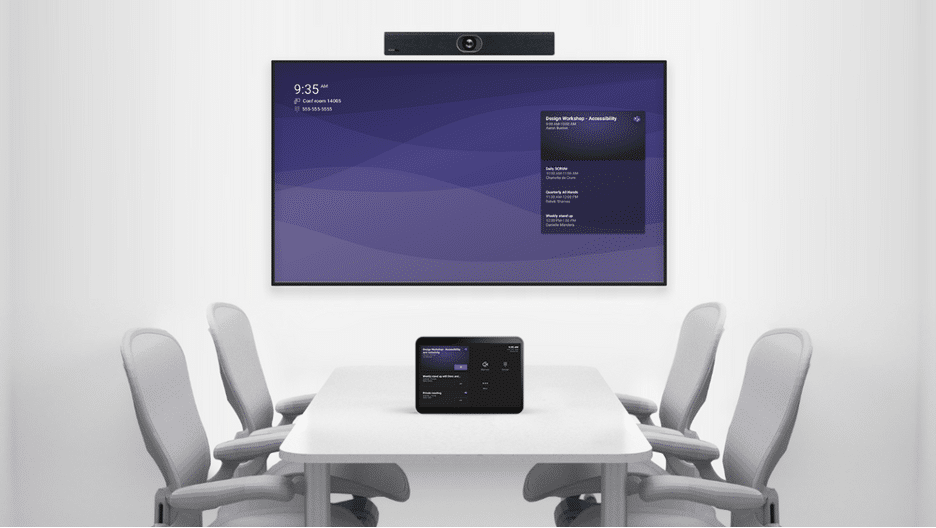
Internal communication is much more efficient with both platforms integrated. If you want to facilitate hybrid meetings, Microsoft Teams Rooms is better than Microsoft Teams alone.
Zoom and Zoom Rooms cater to different aspects of hybrid meetings. Zoom Rooms enhances the hybrid meeting experience with additional features, serving as a dedicated platform to facilitate smooth transitions during meetings. While Zoom is primarily an application for joining meetings, Zoom Rooms is designed as a collaborative space with specialized hardware options, maintaining the interactive elements even when participants are remote. It supports third-party integrations and is optimized for comprehensive video conferencing needs, offering more structured capabilities than Zoom.
Screen Sharing
Both support high-quality screen sharing with minimal latency. Microsoft Teams enables users to share their entire screen, a specific app, or a file. It includes convenient integrations like PowerPoint sharing with slide control.
Zoom supports sharing all or part of a screen, a specific app, files, or a whiteboard. It also includes remote control and annotation features.
Security and Compliance
Teams benefit from Microsoft’s comprehensive security framework, offering advanced security features and compliance certifications suitable for industries with strict regulatory requirements.
Zoom has significantly improved its security measures, including end-to-end user encryptions. However, it has faced scrutiny over security concerns, prompting ongoing efforts to enhance data protection and user privacy.
Pricing and Plans
Microsoft Teams is included in many Microsoft 365 subscription plans, providing a cost-effective solution for businesses already invested in the Microsoft ecosystem. Standalone plans are also available for companies looking for only Teams capabilities.
Zoom offers a free tier with limitations on meeting duration and participant count. Its paid plans are designed to accommodate businesses of all sizes, with features scaling according to the plan chosen.
The chart below breaks down each Microsoft Teams plan’s features. The main differences are meeting duration limits, participant capacity, file storage, and each plan’s Microsoft apps. Note that Office 365 E3 is the only plan that allows you to host large-capacity events.
| Microsoft Teams | Microsoft 365 Business Essentials | Microsoft 365 Business Basic | Microsoft 365 Business Standard | |
|---|---|---|---|---|
| Price* | $0 | $4 per month per user | $6 per month per user | $12.50 per month per user |
| Group Meeting Max Duration | 60 min | 30 hours | 30 hours | 30 hours |
| Max Meeting Participant Capacity | 100 | 300 | 300 | 300 |
| Office Apps and Services Included (in Addition to Teams) | None | None | Exchange, OneDrive, SharePoint, Outlook, Word, Excel, and PowerPoint | Exchange, OneDrive, SharePoint, Outlook, Word, Excel, PowerPoint, Publisher (PC only), and Access (PC only) |
| Personal File Storage and Sharing with OneDrive | – | 10 GB per user | 1 TB per user | 1 TB per user |
| Host Online Events | No | No | No | Yes |
What’s unusual about Microsoft Teams is that paid plans start at $5 per month, which is relatively low for a premium video conferencing solution. This makes Microsoft the winner in the Microsoft Teams vs. Zoom category of “lowest price” for premium plans.
With Microsoft Teams premium plans, you get the virtual meeting app plus access to other Microsoft software, which only adds to the value you receive. The one catch is that paid plans require an annual subscription. Microsoft offers a 30-day trial on all paid plans, so you can try premium plans before committing.
Zoom offers three paid plans in addition to its free plan. The chart below details the key differences among the plans.
| Zoom Basic | Zoom Pro | Zoom Business | Zoom Business Plus | |
|---|---|---|---|---|
| Price | $0 | $159.84 per year, per user | $219.84 per year, per user | $269.88 per year, per user |
| Group Meeting Max Duration | 40 min | 30 hours | 30 hours | 30 hours |
| One-to-One Meeting Max Duration | 30 hours | 30 hours | 30 hours | 30 hours |
| Max Participant Capacity | 100 | 100 | 300 | 300 |
| Min Number of Licenses Required | 1 | 1 | 10 | 10 |
| Large Meeting Add-On | No | Yes | Yes | Yes |
Industry-Specific Considerations
- Education: Teams benefits from integration with educational tools like OneNote Class Notebooks and assignment management. Zoom provides features like breakout rooms that educators value. Both offer plans tailored for educators.
- Healthcare: Both include features to support HIPAA compliance. Teams’ integration with Microsoft 365 supports broader healthcare workflows. Zoom’s simplicity suits providers focused mainly on telehealth visits.
- Government: Teams meets critical government security and compliance standards like FedRAMP and DISA SRG L2. Zoom also offers a government plan to address the public sector’s requirements.
Microsoft Teams vs Zoom Comparison Chart
| Zoom | Teams | |
|---|---|---|
| Market Position | #1 in video conferencing | # 1 in the team collaboration platform |
| Meeting collaboration and productivity features | Screen sharing, remote-control access, collaborative notes, whiteboard, breakout rooms, and chat features | Extensive collaboration features, including robust chat, whiteboard, action item lists, live document collaboration, and a Wiki |
| Customization | Advanced, including noise reduction and light adjustment depending on your environment | Noise reduction is available, but device settings are slightly less customizable. |
| Ease of use | Easy to join from any device, even without an account | App needed to join from mobile devices, but otherwise streamlined |
| Video quality | 1080p at 30fps; handles slow internet better | 1080p at 30fps, but can slow down due to extra chat/collaboration features |
| AI | Meeting catchups, chapter highlights, and AI summaries (all included in paid plans) | Similar offering to Zoom, but only available to users with a Microsoft Copilot license |
| Participant capacity | 1,000 on the Enterprise Plus package (or with a large meeting add-on); 500 on Enterprise; 300 on Business; 100 on Pro | 1,000 on E5 (top Enterprise plan); 300 otherwise |
| Transcripts | Business plans only | Business plans only |
| App integrations | Nearly 2,500 and NextPlane OpenHub | 2,000+, tightly integrated with Microsoft 365 and NextPlane OpenHub |
| Cloud storage | Up to 10GB; unlimited storage for Enterprise users | 1TB for Business Basic users and above |
| Meeting time limit | 40 minutes on the free plan, 30 hours per month on the paid plans | 60 minutes on the free plan, 24 hours per month on the paid plans |
| Recording | Available on all plans | Available on paid plans only |
| Captioning | Auto-captioning on all plans (including free plan), with translated captions available on Business Plus and above | Auto-captioning on all paid plans; translated captions on Business Basic and above. |
| Video Quality | Up to 1080p HD | Up to 1080p HD, often cited as slightly better |
| Recommended Bandwidth | 1.2-1.5 Mbps for HD | 1.2-1.8 Mbps for HD |
| Max Participants | 1,000 meeting, 20,000 view-only | 1,000 meetings, 50,000 webinars |
| Typical Data Usage | 225MB-450MB/hr. group calls | 810MB-2.4GB/hour group calls |
| Integrated Room Solutions | Microsoft Teams Rooms | Zoom Rooms |
| Strength | Deep integration with Microsoft 365 | Focus on video conferencing simplicity and reliability |
Which is Best for Your Business?
The decision between Microsoft Teams and Zoom depends on your business’s specific needs, existing infrastructure, and priorities:
Choose Microsoft Teams if:
- Your business is heavily invested in the Microsoft ecosystem.
- You require a platform that combines communication, collaboration, and productivity tools in one place.
- You need extensive file sharing and real-time document collaboration.
Choose Zoom if:
- Your primary need is for high-quality, reliable video conferencing.
- You prefer a platform that is straightforward and easy to use.
- Your team requires a tool that can be quickly adopted with minimal training.
Extending Collaboration with NextPlane OpenHub
While both Teams and Zoom offer extensive collaboration capabilities within their respective platforms, many organizations face the challenge of enabling seamless communication with external partners, clients, or teams who may use different tools. This is where NextPlane OpenHub comes in.
That’s a groundbreaking solution that enables cross-platform collaboration between Microsoft Teams and Zoom users, as well as other popular platforms like Slack and Webex. With OpenHub, teams can effortlessly connect and communicate with users on other collaboration platforms, breaking down silos and allowing for smooth interoperability.
By leveraging OpenHub, Teams users can collaborate with external stakeholders without switching between multiple apps or managing separate accounts. Its advanced features include:
- Universal Channels: Create channels that span multiple platforms, allowing users from different tools to participate in the same conversation seamlessly.
- Direct Messaging: Enable private 1:1 or group chats between users on different platforms, fostering secure and efficient communication.
- File Sharing: Share files and documents across platforms, ensuring everyone has access to the information they need, regardless of the tool they use.
- Presence Synchronization: View users’ real-time availability status across platforms, facilitating effortless and more effective collaboration.
- Centralized Administration: Manage all Internal & external collaboration from a single interface, simplifying governance, security, and compliance.
By integrating Microsoft Teams with Zoom, organizations can maximize the potential of both collaboration platforms, fostering a more connected, efficient, and productive workforce. Recent studies show This is particularly valuable in today’s multi-platform collaboration landscape, where businesses need to work with a wide range of partners, clients, and stakeholders who may have different tool preferences.
With NextPlane OpenHub, Teams users can seamlessly collaborate with Zoom users and vice versa, ensuring no one is left out of the conversation. This integration breaks down barriers and enables organizations to make the most of their investment in collaboration technology, regardless of the platforms their external partners use.
Conclusion
Both Microsoft Teams and Zoom offer compelling features for businesses looking to enhance their communication and collaboration capabilities. Microsoft Teams is the more holistic solution, designed to facilitate communication and deep collaboration, especially for companies already using Microsoft 365. On the other hand, Zoom focuses on providing a top-notch video conferencing experience and is renowned for its ease of use and reliability.
Ultimately, the choice between Microsoft Teams and Zoom should be based on your business’s unique needs, goals, and current technological ecosystem. By carefully evaluating the features and benefits of each platform, you can make an informed decision that best supports your team’s productivity and collaboration.


